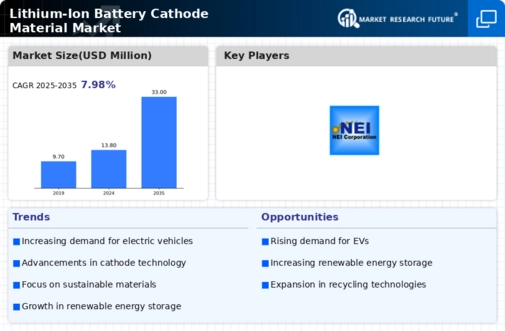Market Share
Lithium Ion Battery Cathode Material Market Share Analysis
The Lithium-Ion Battery Cathode Material Market is a dynamic and fast growing industry that reflects the commercialization of energy storage. For these companies, market share positioning strategies are crucial to staying competitive in an expanding market. Therefore, companies are focused on developing better cathode materials through R and D efforts that offer improved performance. Only through continuous innovation can companies keep up with the needs of lithium-ion battery makers and get a competitive edge. The improvement of the cathode material composition, that is to say increasing energy density and lifespan. Improving the material property makes better high-performance lithiumion batteries. This has attracted firms looking for improved energy storage performance. Several dozen cathode materials are currently being researched and produced by companies, including lithium cobalt oxide (LiCoO2),lithium manganese oxide (LiMn 2 O4) and lithium iron phosphate( LiFePO4). Diversification allows companies to produce a variety of performance products for different market segments with very disparate requirements, opening up its potential market. Establishing joint ventures with lithium-ion battery manufacturers to maintain a market for cathode materials. Joint efforts simplify supply channels, reduce costs and move toward an integrated solution to the energy storage industry's needs. Improving economies of scale and optimizing manufacturing processes for cathode materials in order to reduce their overall cost. Globalize to explore emerging markets, and expand the customer base. By setting up production bases and partnerships in principal markets, companies can better serve local customers as well adapt to different demand patterns throughout various regions. Choosing environmentally friendly manufacturing techniques and materials that meet international standards for sustainability. Posing cathode materials as green would project a company in an excellent light, attract environmentally sensitive customers and thus potential buyers. Using sophisticated manufacturing technologies, including nanotechnology to enhance the efficiency and performance of cathode materials. By staying at the front of manufacturing developments, companies can produce superior materials and remain ahead in competition. Participating in educational projects to educate battery manufacturers and consumers about the advantages of certain cathode materials. Working together with various parties in the industry not only helps to spread knowledge but also promotes a standardized definition of performance metrics for different cathode materials.




Leave a Comment